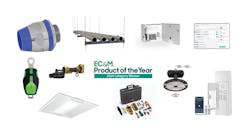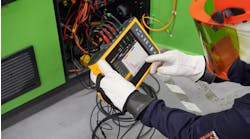Isolated ground (IG) systems have long been considered best practice for reducing noise (Electrical Noise) signals on the power supply of electronic equipment. Nevertheless, maintaining the integrity of an IG system in today's large, digital, networked broadcasting facility is nearly impossible.
Challenges from the faulty installation of wiring and conduit to maintenance, noise corruption, and the incorrect application of IG systems all threaten to harm the very infrastructure that was designed to protect the broadcast environment's power supply. Instead, an alternative approach that delivers separate, clean power — and a robust web of non-isolated solid grounding points — will give the modern broadcast environment the reliable power it needs.
This approach to grounding electrical systems (Electrical Grounding 101 on page C40) encompasses two important aspects. First, the “dirty” equipment power supply (i.e., MEP equipment, motors, fluorescent ballasts, etc.) is separated from the “clean” power supply (i.e., the sensitive broadcast equipment). Second, a web of grounding points is installed for broadcast equipment, which joins together and forms a solid reference grid (click here to see Figure).
Using a grid of copper ribbon on 2-ft squares underneath the broadcast facility's raised floor, the spider web of grounding circuits ensures all equipment is at the same potential. Instead of isolating each circuit and piece of equipment to the separately derived system's grounding points, this spider web of multiple insulated grounding points creates a more reliable, expandable, maintainable, and redundant noise-free power system.
Reliable
Today's broadcast facilities are like data centers — they can't afford to lose power for even a minute. Whether supporting the editing bays, newsrooms, studios, or a paid advertisement on a live broadcast, a reliable electrical infrastructure is a must.
One of the biggest challenges in maintaining reliability within the old IG system is truly isolating all connected equipment within a networked infrastructure. Power corruption and noise from non-sensitive equipment and motor loads can easily occur when clean and dirty power become inadvertently mixed.
Instead, keeping the clean and dirty power lines completely separate, served by separate transformers, panelboards, and raceways, can provide safe and appropriate protection from common and normal mode noise. With separate distribution systems, the “clean” power conductors (also called technical conductors) will be shielded from noise in nearby “dirty” circuits by steel conduit. Normal and common-mode noise will also be mitigated by power conditioners and filters in equipment, such as uninterruptible power supplies (UPSs) and power distribution units (PDUs), serving either the technical or dirty power system.
When Syska Hennessy Group recently installed this type of grounding system in the West Coast TV studio of a cable network giant, it was determined that the studio will yield fewer ground loops than a typical IG system because its equipment, raceways, cables, and more are bonded to the ground at each end as well as at many points in between. Ground bus bars are provided in all equipment rooms, and a grid is provided under the raised floor.
Expandable
The traditional IG system poses a significant challenge to equipment expansion. With each piece of equipment individually tied to the ground, any infrastructure changes (additions or subtractions) could compromise the system's isolation.
Using this alternate approach, however, expansion simply means creating a new point bonded to the existing grid, maintaining the same potential throughout, and leaving the existing power points and the grounded power supply untouched. This holds true for expansion to a different floor or another part of the facility as well.
Maintainable
Corruption to the clean power source is also a risk during both scheduled and unscheduled maintenance of a traditional IG system. When each piece of equipment is isolated from the ground, maintaining this isolation becomes a huge effort — especially when troubleshooting the systems to find the cause of corruption. On the other hand, the spider web design allows maintenance personnel to locate and fix a problem without having to trace the entire networked system.
Redundant
The demand for reliability in the live broadcast environment is now being met with power systems' redundancy in some cases. The challenge is balancing client cost versus need — and designing redundancy for a budget and a variety of risks specific to each facility.
Unlike smaller broadcast facilities, which are typically focused on power capacity, the cable network giant described previously asked Syska to design a 2N+1 redundant electrical power infrastructure that will provide backup for itself and its sister facility on the East Coast. Another smaller local broadcast network asked Syska to back up its power with one robust UPS system and a backup generator, but weren't willing to pay for additional reliability efforts.
Whether large or small, designing an electrical system for capacity without looking at redundancy is a mistake. Make sure each broadcast facility has enough power and that the power capacity is backed up to an appropriate level.
As broadcast studio technology advances toward an all-digital environment, the need for clean uninterruptible power and system flexibility will be paramount. Unlike traditional IG systems, a web of solid grounding points approach to electrical grounding provides reliable, noise-free power systems that can be easily maintained and expanded.
MacFadyen is a registered P.E. with LEED AP credentials and an associate partner at Syska Hennessy Group, Los Angeles. She can be reached at [email protected].
Sidebar: Electrical Noise
Three types of noise can occur in electrical systems: normal, common-mode, and inter-system. Caused by large currents (i.e., photocopiers, laser printers, or ballasts), common-mode noise is any disturbance between the neutral and the equipment ground or grounding conductor, while normal-mode noise is a disturbance created by load switching and starting motors. Inter-system ground noise, or “ground loops,” exists when ground wires supplying different equipment are at different potentials.
While all three can inhibit the typical functions of a broadcast environment, perhaps the greatest threat to power reliability exists in the potential for ground loops. Imagine two computers that are connected through communications cables but are served by different isolated ground systems (i.e., they're located on different floors, etc.). The communication cables linking the two can complete a loop, allowing induced noise currents to flow and creating a “ground loop.”
Sidebar: Electrical Grounding 101
In broadcasting or technology-intensive environments, electrical grounding is required to ensure both personnel safety and equipment protection, providing a stable, low-impedance connection to the earth that controls electromagnetic interference (EMI) or electrical noise.
The two types of grounding required by the National Electrical Code (NEC) include equipment grounding and systems grounding. Equipment grounding is the bonding of all exposed conductive sources, including raceways, boxes, panelboards, and cable trays, bonded together and connected to the earth. System grounding is the connection of the power supply system, including the main utility service, transformers, and generators, to the earth at the point electrical service is established.
Isolated ground (IG) systems are isolated from the rest of the load and an exception to the standard grounding requirements of the NEC. In fact, Secs. 250.74 and 250.75 allow isolated ground only “where required for the reduction of electrical noise.”



